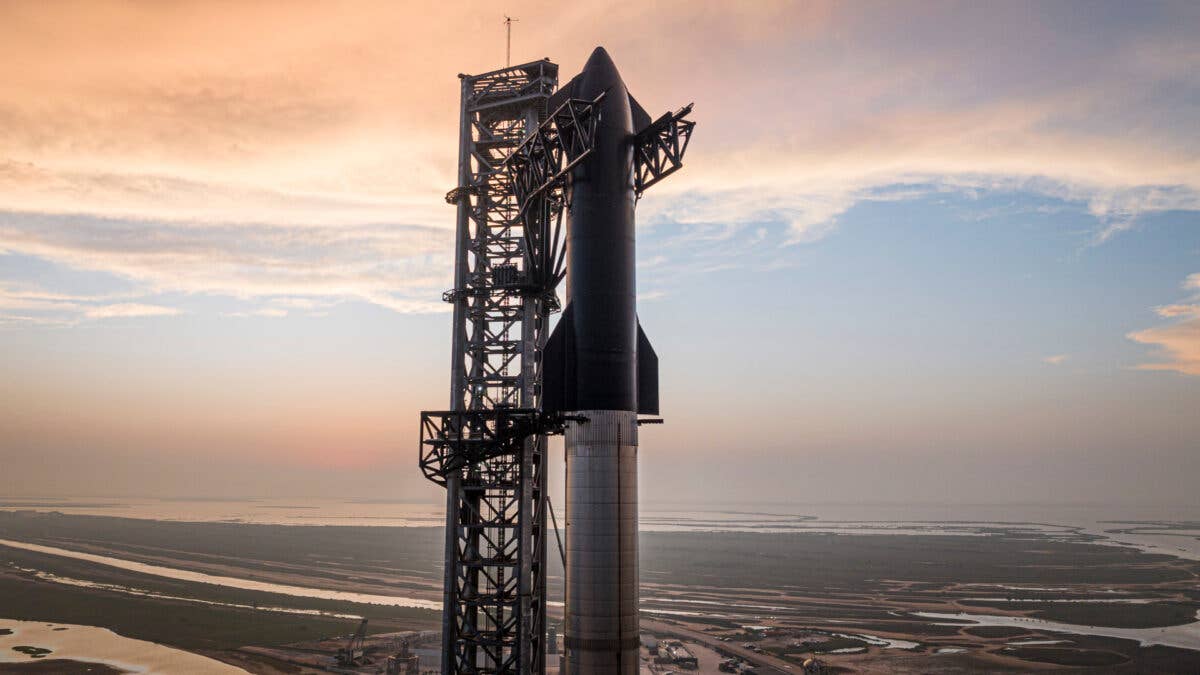SpaceX’s Starship—the Most Powerful Rocket in History—Nears Return to Flight
Starship has been grounded since April after its maiden voyage ended in an explosion, but the massive spacecraft is getting closer to a second test flight.

SpaceX’s Starship rocket and Super Heavy Booster are stacked on the company’s Boca Chica, Texas, launch pad. [Courtesy: SpaceX]
Since its inaugural launch, SpaceX’s Starship rocket has been grounded while the FAA conducted a mishap investigation, which finally closed in September. This week, the agency completed another key step toward issuing a modified launch license for Starship, which would return the spacecraft to action.
“The FAA completed the safety review portion of the SpaceX Starship-Super Heavy license evaluation on October 31,” the agency told FLYING.
The safety review is the “principal component” of the FAA’s vehicle operator license evaluation, which grants companies the authority to launch rockets. In its review, the agency assessed the impact of Starship launches on public health and property damage. It also evaluated SpaceX’s safety organization, system safety processes, and flight safety analysis, as well as quantitative risk criteria related to launch, reentry, and vehicle disposal.
Starship—whose two reusable components, the Super Heavy Booster and Starship upper stage, stand close to 400 feet when stacked together—is the largest and most powerful rocket ever built. But its maiden voyage in April began and ended in flames, when the spacecraft lost control and exploded during stage separation just minutes into the flight.
Meanwhile, the impact of Super Heavy’s 33 Raptor engines on the company’s Boca Chica, Texas, launch pad, Starbase, created a massive crater. Starship’s liftoff broke windows, shook buildings, and sprayed ash and debris over an area far larger than expected, including 6 miles away in the town of Port Isabel.
While the FAA’s license evaluation safety review centered around Starship’s impact to people and property, the agency is now working on an environmental review to gauge its effect on nearby wildlife.
Coordinating with the U.S. Fish and Wildlife Service (USFWS) under the Endangered Species Act, the FAA must produce an updated biological assessment for Starship. An initial biological assessment, published in October 2021, assessed threats to wildlife surrounding Starbase.
According to USFWS, the ongoing environmental assessment focuses on a new water deluge system installed at Starbase, one of several upgrades the company has made to the launch pad since April. Most launch pads have either a water deluge system or a flame trench to suppress heat and sound. But Starbase lacked such a system during Starship’s first launch, which may have exacerbated the damage caused by the engines.
The FAA initiated a consultation with USFWS on October 19, giving the latter 135 days to issue an amended biological opinion based on the FAA’s assessment. However, it does not expect to take the full amount of time.
The FAA’s completion of Starship’s safety review and the ongoing work toward the environmental review bring SpaceX closer to modifying its launch license, which would clear the way for the massive rocket to fly again. But the company may still have hurdles beyond the FAA’s evaluation.
Starship’s maiden voyage was permitted under the FAA’s April written reevaluation of the programmatic environmental assessment (PEA) it awarded to SpaceX in 2022. But the April explosion brought scrutiny upon the PEA in the form of a lawsuit brought against the FAA by five environmental groups, including the Center for Biological Diversity.
The plaintiffs claim the FAA could have mitigated the damage from the launch and subsequent explosion. Had the agency conducted an environmental impact statement (EIS) instead of a PEA “based on SpaceX’s preference,” as the groups allege, the impact may have been less severe.
Both a PEA and an EIS can give an operator the National Environmental Protection Act (NEPA) compliance required to greenlight a launch. But unlike an EIS, the PEA allowed SpaceX to analyze the potential impact of its own launch proposal and may have authorized Starship to fly sooner. The FAA required SpaceX to take more than 75 actions after submitting its PEA. But the lawsuit alleges these were not sufficient to prevent a mishap.
SpaceX in June joined the suit as a codefendant, and it and the FAA are now seeking to dismiss it. If they lose, the FAA would be required to conduct an EIS, which could represent a major setback for Starship.
However, SpaceX last week said Starship is ready to fly pending the approval of its license modification, and the company should still be able to conduct test flights despite the ongoing lawsuit.
Like this story? We think you'll also like the Future of FLYING newsletter sent every Thursday afternoon. Sign up now.

Sign-up for newsletters & special offers!
Get the latest FLYING stories & special offers delivered directly to your inbox






